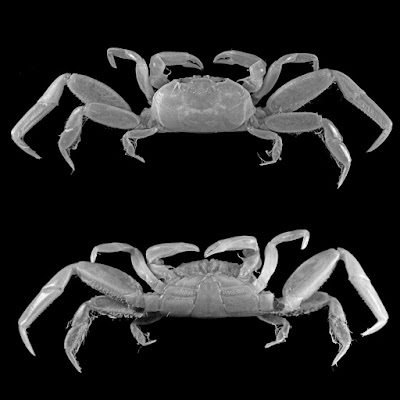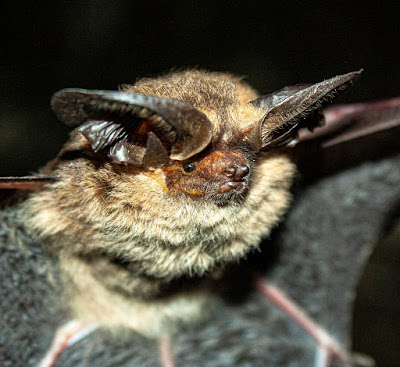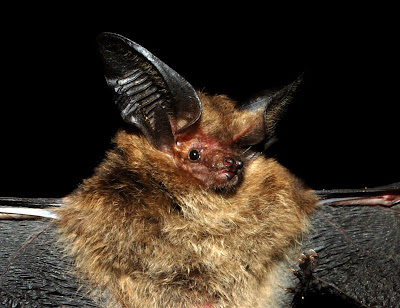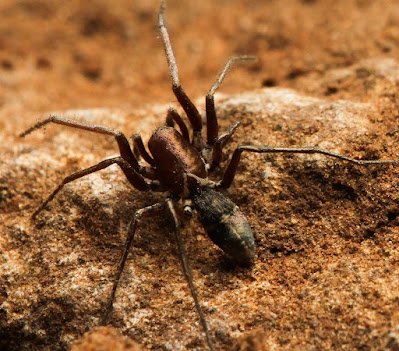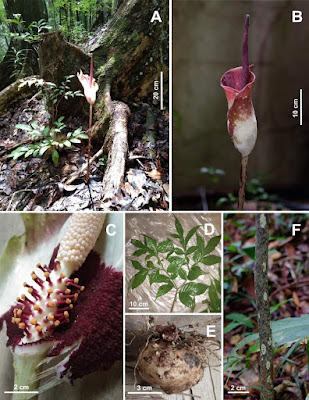[Most Recent Entries] [Calendar View]
Friday, March 5th, 2021
| Time | Event | ||
| 10:11a | [Crustacea • 2021] Tritodynamia bengalensis • A New Species of Brachyuran Crab (Decapoda: Brachyura: Macrophthalmidae) from West Bengal State, India
Abstract Tritodynamia bengalensis n. sp. is described on the basis of a male specimen dredged from the shallow coastal waters of West Bengal state, India. The new species is morphologically similar to T. bidentata Yang & Tang, 2005 and T. serratipes Anker & Ng, 2014, but can be distinguished by the carapace shape, dentition of the pollex, relative length of the dactylus of the third maxilliped, proportions of the propodus of the third pereopod, and structure of the male left gonopod. This is the first record of the genus Tritodynamia from India. Keywords: Crustacea, Tritodynamia, new species, by-catch, West Bengal, India Jigneshkumar N. Trivedi, Santanu Mitra and Peter K. L. Ng. 2021. Tritodynamia bengalensis n. sp., A New Species of Brachyuran Crab from West Bengal State, India (Decapoda: Brachyura: Macrophthalmidae). Zootaxa. 4938(3); 325–330. DOI: 10.11646/zootaxa.4938.3.3 | ||
| 10:13a | [Mammalogy • 2021] A New Species of Long-eared Brown Bat of the Genus Histiotus (Chiroptera) and the Revalidation of Histiotus colombiae
The South American bats of the genus Histiotus comprises between four and eight species, but their taxonomy has been controversial and the limits between species and their distribution are not well understood. In Colombia, Histiotus humboldti and H. montanus colombiae have been recorded, but undescribed species has been suggested. We evaluated the species richness and distribution of Colombian Histiotus using morphological, molecular, and acoustic traits. Our results evidence three species in Colombia, the two previously recorded taxa and a new species from the Cordillera Central of Colombia and northern Ecuador that we describe here. We also revalidated H. colombiae as a full species. H. humboldti is widely distributed in the Colombian and Ecuadorean Andes and can be sympatric with the other two species. H. colombiae is restricted to the Colombian Cordillera Oriental. Finally, we highlight the potential hidden diversity within Histiotus in the Peruvian and Bolivian Andes, the need to resolve the evolutionary relationships of the genus, and its implications to the understanding of the processes that have structured the Andean mammal fauna. Keywords: Andes, Cytochrome b, echolocation calls, morphometry, Vespertilionidae Miguel E. Rodríguez-Posada, Darwin M. Morales-Martínez, Héctor E. Ramírez-Chaves, Daniela Martínez-Medina and Camilo A. Calderón-Acevedo. 2021. Una nueva especie de murciélago pardo de orejas largas del género Histiotus (Chiroptera) y revalidación de Histiotus colombiae [A New Species of Long-eared Brown Bat of the Genus Histiotus (Chiroptera) and the Revalidation of Histiotus colombiae]. CALDASIA. 43(2) DOI: 10.15446/caldasia.v43n2.85424 Los murciélagos suramericanos del género Histiotus comprenden entre cuatro y ocho especies, pero su taxonomía ha sido controversial y los límites entre sus especies y sus áreas de distribución no son bien entendidos. En Colombia, se han registrado a Histiotus humboldti y a H. montanus colombiae, pero se ha propuesto que hay especies por descubrir. Evaluamos la riqueza de especies de murciélagos Histiotus colombianos incluyendo caracteres morfológicos, moleculares y acústicos. Nuestros resultados evidencian la presencia de tres especies en Colombia, los dos taxones previamente registrados y una especie nueva de la Cordillera Central de Colombia y el norte de Ecuador que describimos aquí. Además, revalidamos H. colombiae a nivel de especie. H. humboldti presenta la distribución más amplia en los Andes colombianos y ecuatorianos, y puede estar en simpatría con las otras dos especies. H. colombiae es sólo conocida de la Cordillera Oriental de Colombia. Finalmente, resaltamos la diversidad potencial no descrita de Histiotus en los Andes peruanos y bolivianos, la necesidad de resolver las relaciones evolutivas del género y sus implicaciones en el entendimiento de los procesos que han estructurado la fauna Andina de mamíferos. Palabras clave: Andes, Vespertilionidae, Citocromo b, ecolocalización, Morfometría | ||
| 10:13a | [Arachnida • 2021] Revision and Molecular Phylogeny of the Spider Genus Micaria Westring, 1851 (Araneae: Gnaphosidae) in the Afrotropical Region
Abstract The genus Micaria Westring, 1851 (Araneae, Gnaphosidae) is a group of small (1.85–5 mm) ant-like spiders that can be distinguished from other gnaphosids by their piriform gland spigots that are similar in size to the major ampullate gland spigots. According to the World Spider Catalog, there are 105 species of Micaria in the world, of which only three species are known from the African part of the Afrotropical Region, namely M. chrysis (Simon, 1910), M. tersissima Simon, 1910 and M. beaufortia (Tucker, 1923). The objectives of this study were to revise Micaria in the Afrotropical Region, providing new and updated records for each of the species, evaluating the relationships between them using COI barcoding data, and providing information on their biology, mimetic relationships and feeding ecology. These objectives were met by collecting fresh material from the KwaZulu-Natal, Western Cape, Northern Cape and Free State provinces in South Africa. Fresh material of M. tersissima and M. chrysis were collected from their type localities, Komaggas and Port Nolloth (Northern Cape Province), respectively, for identification and DNA analyses. COI sequences generated, together with those sourced from Barcode of Life Data Systems (BOLD) and GenBank, were aligned using the CulstalW alignment algorithm in the Mega X software, and molecular phylogenetic analyses were performed using MrBayes for Bayesian Inference (BI) and RaxML for maximum likelihood (ML) analyses. Morphological examination of the collected and voucher material yielded 17 new species for the Afrotropical Region, namely M. basaliducta sp. nov. (♀, ♂, South Africa), M. bimaculata sp. nov. (♀, ♂, Mauritania), M. bispicula sp. nov. (♀, ♂, Namibia, South Africa), M. durbana sp. nov. (♀, ♂, South Africa, Zambia), M. felix sp. nov. (♀, ♂, Cameroon, Ethiopia, Malawi, Mozambique, Namibia, South Africa, Zambia, Zimbabwe), M. gagnoa sp. nov. (♀, ♂, Côte d’Ivoire, Mozambique, Mozambique, Tanzania), M. koingnaas sp. nov. (♂, South Africa), M. lata sp. nov. (♂, Namibia, South Africa), M. laxa sp. nov. (♀, South Africa), M. mediospina sp. nov. (♂, South Africa), M. parvotibialis sp. nov. (♀, ♂, Senegal), M. plana sp. nov. (♀, ♂, Ethiopia), M. quadrata sp. nov. (♀, Ethiopia), M. quinquemaculosa sp. nov. (♀, ♂, Namibia, South Africa), M. rivonosy sp. nov. (♀, ♂, Madagascar), M. sanipass sp. nov. (♂, South Africa) and M. scutellata sp. nov. (♂, South Africa). Furthermore, both sexes of M. beaufortia, as well as the male of M. tersissima, are redescribed. Both sexes of M. chrysis are described for the first time, as this species was only known from a juvenile. Of the previously known species, M. beaufortia (Botswana, Ethiopia, Lesotho, Namibia, South Africa, Zimbabwe) and M. chrysis (Côte d’Ivoire, Ethiopia, Lesotho, Namibia, South Africa, Tanzania) are widespread in the Afroptropics, while M. tersissima is only known from South Africa. Both the Bayesian inference and the maximum likelihood analysess recovered Micaria (sensu lato) as monophyletic with the inclusion of the subopaca group. The pulicaria species group was recovered as polyphyletic in both the BI and ML analyses. Four Afrotropical species, as well as the M. rossica Thorell, 1875/M. foxi Gertsch, 1933 group, formed a clade sister to M. formicaria (Sundevall, 1831). Eight of the Afrotropical species now have COI barcoding data uploaded to BOLD. Ruan Booysen and Charles Haddad. 2021. Revision and Molecular Phylogeny of the Spider Genus Micaria Westring, 1851 (Araneae: Gnaphosidae) in the Afrotropical Region. Zootaxa. 4940(1); 1–82. DOI: 10.11646/zootaxa.4940.1.1 | ||
| 10:20a | [Botany • 2021] Amorphophallus calcicolus (Araceae: Thomsonieae) • A New Species from the Bohol Island, Central Visayas, Philippines
Abstract Amorphophallus calcicolus from the forest over karst of Bohol island, Central Visayas, Philippines is hereby described and illustrated. The species is closely related to A. longispathaceus but distinct in having shorter leaves, smaller male zone, depressed disk-shaped ovary, longer styles, ovoid or irregularly shaped warts inside the spathe base, and shallowly 2–3-lobed stigma. Due to anthropogenic factors and a relatively confined distribution, it is hereby proposed as Critically Endangered (CR) following IUCN guidelines. Keywords: aroids, karst, Loboc watershed, Malesia, monocots, taxonomy Maverick N. Tamayo, Liezel M. Magtoto, Melchor S. Sumalinog Jr., Tomas D. Reyes Jr. and Celia M. Austria. 2021. Amorphophallus calcicolus (Thomsonieae, Araceae), A New Species from the Bohol Island, Central Visayas, Philippines. Phytotaxa. 489(2); 229–235. DOI: 10.11646/phytotaxa.489.2.12 |
| << Previous Day |
2021/03/05 [Calendar] |
Next Day >> |
